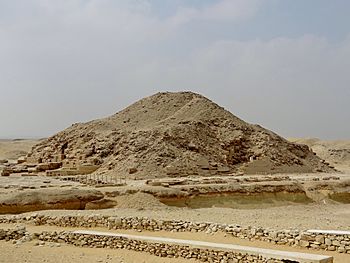Fifth Dynasty of Egypt facts for kids
Quick facts for kids
Fifth Dynasty of Egypt
|
|||||||||
|---|---|---|---|---|---|---|---|---|---|

|
|||||||||
| Capital | Memphis | ||||||||
| Common languages | Egyptian language | ||||||||
| Religion | ancient Egyptian religion | ||||||||
| Government | Absolute monarchy | ||||||||
| Pharaoh | |||||||||
|
• 7–8 years (first)
|
Userkaf | ||||||||
|
• 13 years
|
Sahure | ||||||||
|
• c. 10 years
|
Neferirkare Kakai | ||||||||
| Historical era | Old Kingdom of Egypt | ||||||||
|
|||||||||
The Fifth Dynasty of ancient Egypt was a time when nine kings ruled the land. This period is part of the Old Kingdom, which also includes Dynasties III, IV, and VI. The pharaohs of the Fifth Dynasty ruled for about 150 years. This was from the early 25th century BC to the mid-24th century BC.
Contents
Pharaohs of the Fifth Dynasty
The Fifth Dynasty had nine kings who ruled Egypt. They reigned for about 150 years. This was during the 25th and 24th centuries BC. Historians have different ideas about the exact dates. The order of some kings is also not fully clear. For example, there are different ideas about the reign of Shepseskare.
Here are the known rulers of the Fifth Dynasty:
| King's Name | Horus (Throne) Name | Image | Estimated Reign | Pyramid Location | Queen(s) |
|---|---|---|---|---|---|
| Userkaf | Irimaat |  |
7 years | Pyramid in Saqqara | Khentkaus I ? Neferhetepes |
| Sahure | Nebkhau |  |
13 years, 5 months and 12 days | Pyramid in Abusir | Meretnebty |
| Neferirkare Kakai | Neferirkare |  |
20 years | Pyramid in Abusir | Khentkaus II |
| Neferefre | Neferkhau |  |
2 to 3 years | Unfinished Pyramid in Abusir | Khentkaus III ? |
| Shepseskare | Shepseskare | A few months | Possibly in Abusir | ||
| Nyuserre Ini | Nyuserre |  |
24 to 35 years | Pyramid in Abusir | Reptynub |
| Menkauhor Kaiu | Menkauhor |  |
8 or 9 years | "Headless Pyramid" in Saqqara | Meresankh IV? |
| Djedkare Isesi | Djedkare |  |
33 to over 44 years | Pyramid in Saqqara | Setibhor |
| Unas | Wadjtawy |  |
15 to 30 years | Pyramid in Saqqara | Nebet Khenut |
The palaces of these kings were in Ineb-hedj, also known as "White Walls." This was the capital city of ancient Egypt.
Life and Trade in the Fifth Dynasty
During this time, Egyptians traveled far for important resources. They went to Wadi Maghareh and Wadi Kharit in the Sinai to mine for blue turquoise and shiny copper. They also went to quarries near Abu Simbel for a type of rock called gneiss.
Trade ships sailed south to a place called Punt. There, they got green malachite, sweet-smelling myrrh, and a mix of gold and silver called electrum. Archeologists have also found proof of Egyptian visits to Byblos, a city in Phoenicia. Some finds near the Sea of Marmara might show even more trade, but these are still a mystery.
Userkaf and Religious Changes
It's not fully known how Pharaoh Userkaf started this new dynasty. An old story, written much later, says that three brothers would become kings. These brothers were Userkaf, Sahure, and Neferirkare. However, experts today think this story is more of a legend than a true historical account.
During the Fifth Dynasty, Egyptian religion changed a lot. The first known copies of special prayers for royal tombs appeared. These are called the Pyramid Texts. They were carved inside the pyramids.
The god Ra, the sun god, became very important. Kings from Userkaf to Menkauhor Kaiu built temples just for Ra. These temples were usually near Abusir. Later in the dynasty, the god Osiris also became very important. You can see this in the writings found in the tomb of Unas.
Djedkare Isesi and Wise Sayings
Among the non-royal people of this time, Ptahhotep was famous for his wisdom. He was a vizier, a high official, for King Djedkare Isesi. A famous collection of wise sayings, called The Maxims of Ptahhotep, is said to have been written by him.
Non-royal tombs also started to have decorations and writings. Instead of religious prayers, these tombs had stories about the life of the person buried there.
See also
 In Spanish: Dinastía V de Egipto para niños
In Spanish: Dinastía V de Egipto para niños

